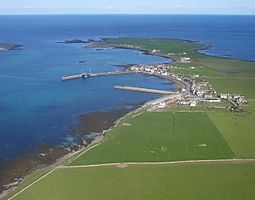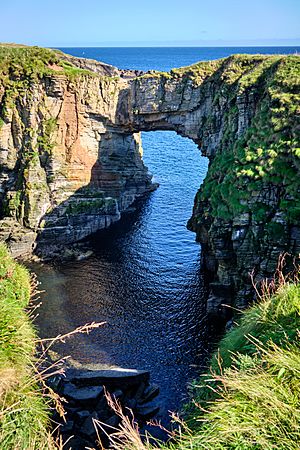Stronsay facts for kids
| Norse name | Strjónsey |
|---|---|
| Meaning of name | Old Norse for "good fishing and farming island" |
 An aerial view of Whitehall, with Grice Ness at the end of Stronsay's north-eastern peninsula |
|
| OS grid reference | HY669239 |
| Coordinates | 59°06′N 2°36′W / 59.1°N 2.6°W |
| Physical geography | |
| Island group | Orkney |
| Area | 3,275 hectares (13 sq mi) |
| Area rank | 27 |
| Highest elevation | Burgh Hill 44 metres (144 ft) |
| Administration | |
| Sovereign state | United Kingdom |
| Country | Scotland |
| Council area | Orkney Islands |
| Demographics | |
| Population | 349 |
| Population density | 10.7 people/km2 |
| Largest settlement | Whitehall |
Stronsay is an island in Orkney, Scotland. It's often called 'Orkney's Island of Bays' because of its wiggly shape and long coastline. You'll find three big bays here: St Catherine's Bay, the Bay of Holland, and Mill Bay.
The island covers about 12.6 square miles (32.75 square kilometers). Its highest point is 144 feet (44 meters) tall. Around 349 people live on Stronsay. The main village is Whitehall, where you can visit a heritage center.
Some cool places to see on the island include the Vat of Kirbister, which is a natural rock arch. People say it's the best one in Orkney! There are also white sand beaches in the bays and lots of different seabirds, like Arctic terns.
Contents
What is Stronsay like?
Land and Rocks
Like most of Orkney, Stronsay is made of Old Red Sandstone. This type of rock has created good soil in many areas. The island is mostly flat and low to the ground.
On the east coast, you can see amazing rock shapes. One of the most famous is the Vat of Kirbister, a natural rock arch. The coast around Odiness Bay also has many interesting features. These include deep cracks called geos, caves, flat rock platforms, and tall sea stacks. One stack, Tam’s Castle, is said to have once been home to a hermit.
Nearby Islands
Stronsay is the seventh largest of the Orkney Islands. It has several smaller islands nearby. These include Linga Holm, Papa Stronsay, the Holm of Huip, and the Holms of Spurness.
To the north of Stronsay is Sanday. To the northwest is Eday. To the southwest, you'll find Shapinsay and Mainland Orkney. The small island of Auskerry is directly to the south.
A Look Back in Time: Stronsay's History
Ancient Discoveries
In April 2007, two flint arrowheads were found on Stronsay. Experts think these tools are very old, possibly from 10,000 to 12,000 years ago. This means they could be some of the oldest human-made objects ever found in Scotland! They were discovered with other tools on a farm.
Busy Times in the 18th and 19th Centuries
Today, Stronsay is mostly a farming island. But in the 1700s and 1800s, it was a very busy place. Up to 5,000 people worked here collecting kelp (a type of seaweed) and curing herring fish.
The population of the island was over 1,000 people for the whole 1800s. In 1891, 1,275 people lived here, not counting the many workers who came just for the herring season. The kelp industry started in 1727 and was very successful for many years. You can still see the ruins of some of the kilns (ovens) used for burning kelp.
Life on Stronsay Today
People and Work
In 2011, 349 people lived on Stronsay, which was a small increase from 342 in 2001. Farming and fishing are still the main jobs on the island. The local community is working hard to bring more visitors to Stronsay and improve things for tourists.
Most of the homes are spread out along the main road. However, the main village is Whitehall, located in the north. It has a row of houses along the seafront and two piers. These piers remind us that Whitehall started as a herring fishing hub in the 1800s. In Whitehall, you can find places to stay like the Stronsay Hotel.
Getting Around
Orkney Ferries offer boat trips from Whitehall to Kirkwall on the Orkney Mainland. You can also fly to Kirkwall from the island's airstrip, which is also in the north.
Whitehall looks out over the small island of Papa Stronsay. On Papa Stronsay, you can see a monastery where monks live. Visitors are welcome there, and the monks can help arrange boat trips.
Education and Community
The island's school is well-equipped. It teaches children from nursery age through primary and secondary school.
The Moncur Memorial Church is the main Church of Scotland church on Stronsay. There is also a Catholic chapel in Whitehall.
Stronsay has a lively craft community with several special shops. The island is also known for having a very hard-working mechanic who travels all over Orkney to fix vehicles, farm machines, and boats.
Wildlife on Stronsay
Even though Stronsay has very few trees, its rich soil helps many wild flowers grow. You might spot oysterplant, frog orchids, and adder's tongue.
Birds of Stronsay
The island is a great place for birdwatching, and many rare birds have been seen here. Common birds include whooper swans and different kinds of ducks and geese. You might also see common redshanks, common snipes, and common quails. The great skua and corn bunting are also found here. The corncrake, which is rare in Scotland, can sometimes be heard.
Many seabirds can be seen from Lamb Ness and Lamb Head. The Stronsay Bird Reserve is considered one of the best places in Europe to spot rare birds that are migrating. These include the American Golden Plover, Arctic Redpoll, Scarlet Rosefinch, and Tawny Pipit.
Marine Animals
You can often spot seals in many places around the island. Good spots include the Ayre of the Myers, which is a popular picnic area near Whitehall. You can also see them at the two south-facing bays, Houseby and Sand of Crook, or from the seal-hide near Holland Bay.
Some unusual birds that have been seen visiting Stronsay include:
- American golden plover
- Arctic redpoll
- Pied wheatear
- Rustic bunting
- Scarlet rosefinch
- Tawny pipit
- Different kinds of warblers, such as Radde's warbler, marsh warbler, and subalpine warbler.
Images for kids
See also
 In Spanish: Stronsay para niños
In Spanish: Stronsay para niños





